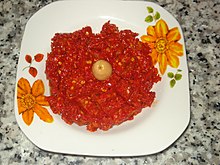food.wikisort.org - Dish
Harissa (Arabic: هريسة harīsa, from Maghrebi Arabic) is a hot chili pepper paste, native to the Maghreb. The main ingredients are roasted red peppers, Baklouti peppers (بقلوطي), spices and herbs such as garlic paste, caraway seeds, coriander seeds, cumin and olive oil to carry the oil-soluble flavors.[1] Rose harissa, made with rose petals, is also made.[2]
 | |
| Alternative names | هريسة |
|---|---|
| Type | Paste |
| Region or state | Tunisia |
| Main ingredients | Red peppers |
| Ingredients generally used | Baklouti pepper |
Etymology
As harissa is created by pounding chilis, the word derives from the Arabic verb, 'harasa' (Arabic: هرس) which means 'to pound' or 'to break into pieces.'[3]
History
As in European cuisine, chili peppers were imported into Maghrebian cuisine by the Columbian exchange,[4] presumably during the Spanish occupation of Tunisia between 1535 and 1574.[5]
Algeria
In Algeria, harissa is commonly added to soups, stews, and couscous.[6] Harissa paste can also be used as a rub for meat[7] or eggplants.[8] Another significant producer is Algeria's Annaba Province,[9] which is also a significant consumer.[10] According to cookbook author Martha Rose Shulman, premade harissa tastes rather different from that which is served in Tunisian and expatriate restaurants.
Tunisia
Recipes for harissa vary according to the household and region. Variations can include the addition of fermented onions or lemon juice. Prepared harissa is sold in jars, cans, bottles and tubes. Harissa is sometimes described as "Tunisia's main condiment",[11] even "the national condiment of Tunisia",[12] or at least as "the hallmark of Tunisia's fish and meat dishes".[13] In Tunisia, harissa is used as an ingredient in a meat (poultry, beef, goat, or lamb) or fish stew with vegetables, and as a flavoring for couscous. It is also used for lablabi, a chickpea soup, and fricasse.
Tunisia is the biggest exporter of prepared harissa.[14] In 2006, the Tunisian production of harissa was 22,000 tonnes, incorporating about 40,000 tonnes of peppers.[15] Tunisian harissa is often made with chilis grown around Nabeul and Gabès, which are relatively mild, scoring 4,000–5,000 on the Scoville scale.[16]
Morocco
Moroccan cuisine has also adopted harissa, using it as a side condiment for tagines, or sometimes mixed into dishes.
Israel
In Israel, harissa is a common topping for sabich[17] and shawarma.
Filfel chuma
Filfel chuma (Hebrew: פלפלצ'ומה), also spelled pilpelshuma, literally "pepper garlic", is the typical chili sauce of Libyan Jewish cuisine which is very similar to the harissa.[18] It comes from Libyan cuisine,[citation needed] where it is known as maseer (Arabic: المصير or مسّير حار mseyer).[19][20] It is also known by other names such as filfil mukhalal (فلفل مخلل) and filfil makbos (فلفل مكبوس).[21] It is made from powdered sweet and hot peppers and crushed garlic. Other ingredients, such as ground caraway seeds, cumin, lemon juice, and salt are sometimes added.[18]
It serves as a condiment and as an ingredient in dishes such as salads, meat, fish, legumes and rice, and egg dishes such as shakshouka.
See also
References
- @NatGeoUK (2019-08-16). "Breaking bread: coastal cuisine and family feasts in Tunisia". National Geographic. Retrieved 2021-01-05.
- Pip Sloan (1 October 2019). "Six of the best harissa pastes, tried and tested". The Daily Telegraph. Archived from the original on 2022-01-12.
- Jose (2016-07-22). "The Story of Harissa". Belazu Ingredient Company. Retrieved 2021-02-08.
- Morse, Kitty; Lucy Malouf (1998). Artichoke to Za'atar: Modern Middle Eastern Food. U of California P. p. 66. ISBN 978-0-8118-1503-1.
- Gil Marks (2008). Olive Trees and Honey: A Treasury of Vegetarian Recipes from Jewish Communities Around the World. Northwest African Chili Paste (Harissa): Wiley. ISBN 978-0-544-18750-4.
- Sari Edelstein (2010). Food, Cuisine, and Cultural Competency for Culinary, Hospitality, and Nutrition Professionals. Jones & Bartlett Publishers. p. 345. ISBN 978-1-4496-5968-4.
- Fayed, Saad. "Flank Steak with Harissa". About.com. Archived from the original on 2009-06-08. Retrieved 2009-08-02.]
- "Baby Eggplant with Harissa and Mint". Ashbury's Aubergines. Retrieved 2009-08-02.
- Oxford Business Group (2008). The Report: Algeria 2008. Oxford Business Group. p. 230. ISBN 978-1-902339-09-2.
- Ken Albala (2011). Food Cultures of the World Encyclopedia. ABC-CLIO. p. 7. ISBN 978-0-313-37626-9.
- Linda Civitello (2011). Cuisine and Culture: A History of Food and People. John Wiley & Sons. p. 244. ISBN 978-1-118-09875-2.
- Jessica B. Harris (1998). The Africa Cookbook: Tastes of a Continent. Simon and Schuster. p. 137. ISBN 978-0-684-80275-6.
- Marshall Cavendish (2006). World and Its Peoples. Marshall Cavendish. p. 1282. ISBN 978-0-7614-7571-2.
- Tunisian Harissa Export cepex.nat.tn Archived September 6, 2009, at the Wayback Machine
- Oxford Business Group. The Report: Tunisia 2008. Oxford Business Group. p. 195. ISBN 978-1-902339-93-1.
- Donna Wheeler; Paul Clammer; Emilie Filou (2010). Tunisia. Lonely Planet. p. 53. ISBN 978-1-74179-001-6.
- Jane Hughes (2013). The Adventurous Vegetarian: Around the World in 30 Meals. New Internationalist Publications, Limited. p. 182. ISBN 978-1-78026-124-9.
- Gur, Jana; (et al.) (2007). The Book of New Israeli Food: A Culinary Journey. Schocken Books. pg. 295. ISBN 9780805212242
- How to make Libyan maseer
- North African hot recipes
- How to prepare mseyer in the Libyan cuisine
На других языках
- [en] Harissa
[ru] Харисса (соус)
Хари́сса (араб. هَرِيسَة hари́сса), также ари́сса — острый пастообразный соус красного цвета из перца чили (иногда высушенного или вяленого) и чеснока с добавлением кориандра, зиры, соли и оливкового масла. Приправа используется главным образом в блюдах тунисской кухни и кухонь других магрибских стран[1], а также распространена в израильской и европейской кухнях. Для каждой из кухонь существует свой собственный рецепт хариссы, тунисская — самая острая, так как содержит больше всех перца чили. По шкале Сковилла имеет жгучесть 4500-5000 единиц[2].Другой контент может иметь иную лицензию. Перед использованием материалов сайта WikiSort.org внимательно изучите правила лицензирования конкретных элементов наполнения сайта.
WikiSort.org - проект по пересортировке и дополнению контента Википедии
